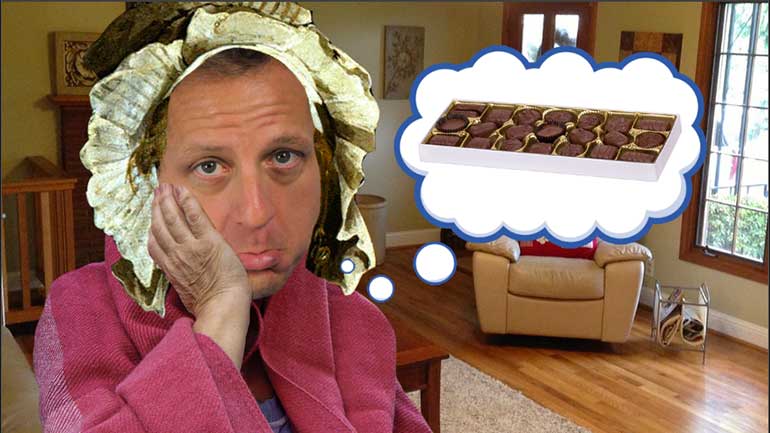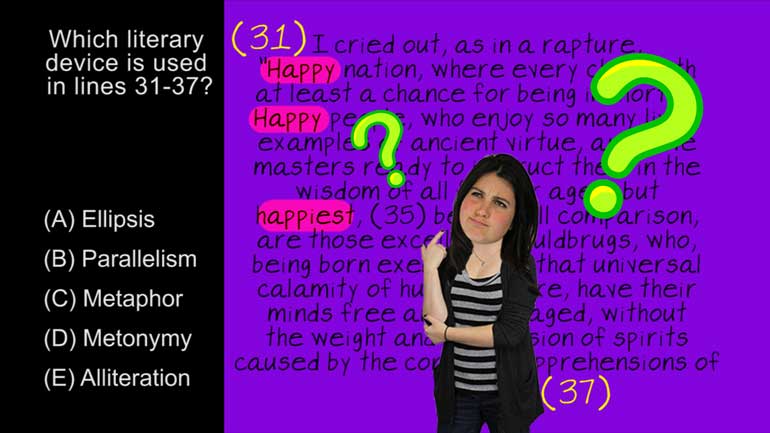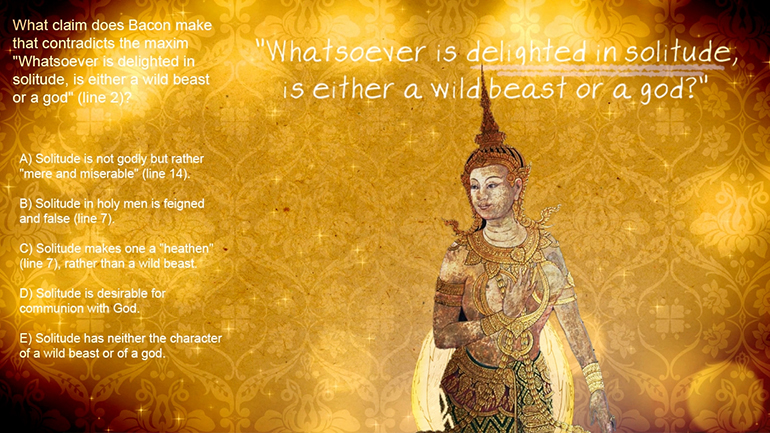ShmoopTube
Where Monty Python meets your 10th grade teacher.
Search Thousands of Shmoop Videos
Physics: Impulse Problems 5 Views
Share It!
Description:
Time to learn about impulse problems…and no, not the fact that we ate an entire pizza last night. We’re talking impulse as it relates to physics.
Transcript
- 00:00
smell impulse problems maybe we can't control impulses but when we can solve [writing on chalk board]
- 00:07
them you know it's a graphing them that's one way to solve I mean that was
- 00:11
our kind impulsive formula clever I mean for some impact that's Steven Seagal
- 00:17
America where like when Tiger Woods hits the golf ball there it's impact you all
- 00:22
right well you know jugglers don't get a lot of respect these days juggling used [juggler on busy street]
Full Transcript
- 00:26
to be a pretty good career few hundred years ago you could travel the
- 00:30
countryside as part of some sort of merry band and if you were lucky well [juggler as part of a band]
- 00:34
maybe you'd get to perform for a king or a queen or at least maybe some lousy [juggler as a mime in front of royalty]
- 00:38
Duke or something well these days it's a tough gig but I've got a PhD in physics
- 00:44
and I've got to put my degree to use somehow okay so this is an
- 00:48
unconventional career choice for someone with an advanced physics degree and sure [man talking from couch]
- 00:53
all that time I spent studying the best ways to detect neutrino interactions
- 00:58
doesn't really help me keep five burning torches from setting me on fire but as
- 01:04
you probably realize by now there's a lot of physics going on in juggling for
- 01:08
example my hands have to provide a certain amount of force to throw a ball
- 01:13
up in the air and they also have to provide a force to stop the ball from
- 01:16
falling on its way down and when I'm doing all of this while riding a
- 01:21
unicycle yeah there are a whole bunch of forces going on all right let's focus on
- 01:25
the moneymakers the hands these puppies are what bring in the crowds and they're [hands on screen]
- 01:30
what creates the impulse that changes the ball's momentum [writing on chalk board]
- 01:34
well impulse is the measure of a change in momentum another way to describe
- 01:37
impulses as a measure of force applied over a span of time so when I throw a
- 01:42
ball the air my hands and arms apply force to the ball to give it enough [juggler with two balls]
- 01:45
acceleration to move upwards and that acceleration also affects the balls
- 01:49
momentum well same thing when I catch the ball my hand applies force to create
- 01:54
negative acceleration slowing the ball down and reducing its momentum and all
- 01:58
this impulse stuff is graphical woohoo we can whip up a force versus time graph
- 02:04
and just start drawing all over the place well not all over the place the [graph on screen]
- 02:08
graph should actually you know make sense all right well here's a graph of
- 02:11
me chasing after some key who stole one of my juggling balls the
- 02:15
amount of force being applied is reduced over time as I lost my breath and you
- 02:20
know slowed down all right we can calculate the impulse by finding the
- 02:23
area of this triangle that our graphed line creates everything under this line
- 02:28
represents the change in momentum well how do we find the area of a right [writing on chalk board]
- 02:32
triangle yeah well the good old Pythagorean theorem it tells us that a
- 02:36
squared over B squared equals C squared well C is the hypotenuse of the triangle
- 02:40
and a and B are the other sides yeah it doesn't matter which side is a which [graph on screen]
- 02:45
side is B just so long as neither of them should actually be C you see all
- 02:50
right well now we could have all sorts of other shapes on this graph rectangles
- 02:55
trapezoids ocean waves okay the last one would mean there's some pretty crazy
- 03:01
impulse going on but well you know still if you need to refresh your geometry
- 03:06
skills well you can find the handy dandy little shmoop learning guide here all [Shmoop website]
- 03:10
right well the equation for impulse is pretty straight forward impulse which is
- 03:14
that J signe there that equals force times a span of time remember just
- 03:20
because something happens really fast doesn't mean that it happens
- 03:23
instantaneously at least not in physics terms like when a 6-iron hits a golf
- 03:28
ball well the ball in the club are only in contact for less than half a
- 03:31
millisecond which is about a thousand times faster than it takes you to blink
- 03:35
your eye admit it right now you're trying to blink your eye really fast [woman blinking on couch]
- 03:39
aren't you yeah try as hard as you can but your blink will still take about a
- 03:43
hundred milliseconds but less than half a millisecond is enough time for us to [woman using calculator]
- 03:48
calculate an impulse we just saw the equation for impulses force times time
- 03:54
but another way to find the impulse is to figure out the change in momentum [writing on chalk board]
- 03:57
over time so we can find a starting momentum in a final momentum subtract
- 04:02
that starting figure from the ending one and get our impulse now I don't know how
- 04:06
you play golf but when I play the ball starts out and not moving at all meaning
- 04:11
its initial velocity is zero and let's say that after impact the ball moves it [man hits golf ball]
- 04:15
in 85 miles an hour sure the pros hit the ball with a bit more speed but well
- 04:19
that's why they're pros I'd like to see them juggle four chainsaws
- 04:22
at a time 85 miles an hour converts to about 38 meters a second so that's our
- 04:27
final velocity to calculate the final momentum though we also need to know the
- 04:31
ball's mass like any good juggler I know the mass of every single spherical [man measuring balls]
- 04:35
object I own so this ball has mass of 45 grams or point 0 4 or 5 kilograms
- 04:41
momentum is mass times velocity in point zero four five kilograms times thirty [writing on chalk board]
- 04:46
eight meters a second gives us a final momentum of 1.7 kilogram meters a second
- 04:51
and since the starting momentum is Zil to our final momentum is also our
- 04:55
impulse well those units are important enough
- 04:58
for us to take a quick look at them the units for impulse and momentum are
- 05:02
kilogram meters a second which makes sense since momentum is mass measured in
- 05:07
kilos times velocity which is measured in meters per second you following here
- 05:11
people let's take a look at our first equation force times the time span
- 05:16
well forces measured in Newtons otherwise known as kilogram meters per
- 05:20
second squared and time is measured in well seconds what happens when we
- 05:25
multiplied Newtons by seconds well one of the instances of seconds is cancelled
- 05:30
out on top and the bottom leaving us with just a plain old s on the bottom
- 05:33
there now 1.7 kilogram meters a second looks
- 05:36
like a pretty small number which is because we're using a pretty small ball
- 05:41
but how much force is required to generate that momentum well to find out
- 05:45
we can rearrange our impulse equation if impulse equals Force Times time then
- 05:50
force equals impulse divided by time and our time span is just an itsy-bitsy
- 05:54
little thing about 41 10 thousandths of a millisecond four point zero zero zero
- 06:00
four one seconds yeah when we divide our impulse by that number we find a force
- 06:05
of about forty 100 Newton's which is not an itsy-bitsy number at all 4100 Newtons
- 06:10
is about 920 pounds of force it's enough to make you feel sorry for that poor
- 06:16
golf ball well another important thing to [Isaac Newton's portrait]
- 06:17
recognize is that Newton's laws of motion x' aren't going anywhere so when
- 06:22
I'm juggling bowling balls and I apply a certain amount of force upwards on the
- 06:25
ball to get it airborne the ball applies the same amount of force down on me [man juggling balls]
- 06:31
luckily I've got more math than a bowling ball so I'm not pushed through
- 06:35
the stage here although my arms sure do get tired
- 06:38
and the life of a juggler isn't as glamorous as it seems people in fact the
- 06:42
fast-paced lifestyle of juggler makes me fantasize about how to get away what if
- 06:47
aliens were out there just looking for someone to take back to their home [flying saucer in space]
- 06:50
planet of course they'd probably have little probes first so what yeah moving
- 06:54
on alright say there's a probe out there with a mass of four kilograms yeah not
- 06:59
moving just chilling in space analyzing data to find the perfect specimen to
- 07:03
teach the beings on its world all about it no I don't know you know the finer
- 07:08
points of the Boston shuffle well it senses an incoming asteroid so it fires
- 07:12
its thrusters to get out of the way and here's a graph of the force versus time
- 07:16
there what's the impulse on the probe and what's its final velocity like I [graph on screen]
- 07:21
said before when we have a graph like this we can find the impulse by
- 07:24
calculating the area under the line well the last time we saw a graph like this
- 07:28
we had a triangle to deal with because the force changed over time but now
- 07:32
we've got a rectangle one of geometries greatest-hits really and to find the
- 07:37
area of a rectangle we just multiply the base by the height with a height of 800 [writing on chalk board]
- 07:41
Newtons and a base of three seconds we find an impulse of 2,400 kilogram meters
- 07:46
a second now we need to find the final velocity it'll be a little more
- 07:50
complicated but nothing we can't handle we know impulse is the measure of a
- 07:53
change in momentum here's the equation when we break momentum down into its
- 07:57
components we're trying to solve for V sub F and the probes mass is four
- 08:02
kilograms since the alien probe started off with a velocity of zero well that
- 08:07
initial momentum will also be zero so that leaves us with 2,400 kilogram
- 08:12
meters equaling four kilograms times the final velocity but when we divide both
- 08:17
sides over the equation by four kilograms we find a final velocity of
- 08:20
600 meters per second Wow alien tech is no joke at least not the alien tech I
- 08:26
daydream about but sadly no aliens are gonna take me away anytime soon so I
- 08:30
gotta keep practicing days like this make me think I could have found a [man juggling]
- 08:34
better use for that doctorate in physics now what job brings you more respect in
- 08:39
juggling it does get frustrating sometimes though and sometimes I have to
- 08:42
lash out like when I'm working on a new trick and the balls fall all over the
- 08:46
place my passion might lead me to kick one of the
- 08:49
stupid stinking falls across the room all right deep breaths remember the
- 08:52
jugglers code if the ball has a mass of 0.1 kilogram said my foot sends it
- 08:56
flying at a velocity of 12 meters a second what's the impulse on the ball
- 08:59
and if the collision between foot and juggling apparatus last point oh three
- 09:03
seconds what's the force of impact okay so impulse equals Force Times time
- 09:08
right now we don't know the impulse we don't know the force and all we know is
- 09:12
the time two unknown variables equals in the oh solution but just like last time
- 09:16
we can use the other equation for impulse that's the one using the change
- 09:21
in momentum well the ball was at rest when my toe connected so the initial
- 09:24
momentum is zero the final velocity was 12 meters a second and when we multiply
- 09:29
that by the mass point zero one kilograms we find an impulse of 1.2
- 09:35
kilogram meters a second now we can go back to our first equation rearrange it
- 09:39
to solve for force and plug in our numbers well 1.2 kilogram meters a
- 09:43
second divided by 0.03 seconds equals a force of 40 Newtons I'm okay with that
- 09:47
maybe I need to incorporate more kicking into my act so sure I could probably be [man kicking ball with foot]
- 09:52
making more money if I used my physics degree to work for a saw or if I used it [man juggling inside NASA control room]
- 09:56
in some sort of quantum computing job or even if I just flipped burgers but
- 10:00
juggling isn't about the money it's about love of art and love of merely
- 10:05
burning my face off with lit torches and it's about physics acceleration impulse
- 10:10
forces all that stuff and more is involved in this ancient tradition which
- 10:13
leaves me with just one more question specifically for my mom and I brought
- 10:17
some money
Up Next
When you're about to marry the love of your life, not many things could stop you. However, finding out that your future hubby is keeping his crazy...
Related Videos
Here at Shmoop, we work for kids, not just the bottom line. Founded by David Siminoff and his wife Ellen Siminoff, Shmoop was originally conceived...
ACT Math: Elementary Algebra Drill 4, Problem 5. What is the solution to the problem shown?
AP® English Literature and Composition Passage Drill 1, Problem 1. Which literary device is used in lines 31 to 37?
AP® English Literature and Composition Passage Drill 2, Problem 1. What claim does Bacon make that contradicts the maxim "Whatsoever is delig...




